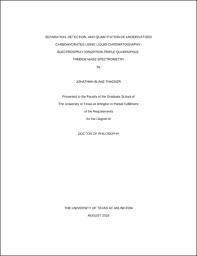
ATTENTION: The works hosted here are being migrated to a new repository that will consolidate resources, improve discoverability, and better show UTA's research impact on the global community. We will update authors as the migration progresses. Please see MavMatrix for more information.
Show simple item record
| dc.contributor.advisor | Schug, Kevin A. | |
| dc.creator | Thacker, Jonathan B. | |
| dc.date.accessioned | 2019-08-29T20:58:39Z | |
| dc.date.available | 2019-08-29T20:58:39Z | |
| dc.date.created | 2018-08 | |
| dc.date.issued | 2018-08-10 | |
| dc.date.submitted | August 2018 | |
| dc.identifier.uri | http://hdl.handle.net/10106/28655 | |
| dc.description.abstract | Carbohydrate analysis has many important implications in health, consumer products, and industrial processes. Among many possible analytical techniques for their analysis, mass spectrometry (MS) is an attractive approach, offering high sensitivity and specificity. In particular, electrospray ionization (ESI)-MS affords several advantages over other ionization techniques: the ability for direct coupling with upstream chemical separation techniques, its suitability for quantitation, and its compatibility with relatively inexpensive quadrupole mass analyzers for the analysis of high molecular weight compounds. However, the sensitivity of ESI-MS towards carbohydrates tends to be much less than for other classes of compounds, such as peptides. This is due to their lack of easily protonable or deprotonable chemical groups as well as their high hydrophilicities.
Increasing an analyte’s sensitivity in ESI-MS can be achieved by optimizing detection strategies and solvent parameters. Flow injection analysis-ESI-tandem MS (MS/MS) was used to investigate the influence of solvent parameters on the signal intensity of glucose. Solvent parameters explored included the organic solvent and its ratio to water, the additive and its concentration, and solution pH. The use of ammonium trifluoroacetate in 80:20 methanol:water in the positive ionization mode resulted in the highest signal intensities. It was also found that acetonitrile suppressed ionization in the positive ionization mode.
The effects of solvent parameters on the relationship between response factors and concentrations was also studied for glucose, sucrose, and raffinose using a continuous stirred tank reactor coupled to ESI-MS/MS. This technique is able to generate a continuum of response factors across a wide concentration range from a single injection. The profiles and magnitudes of the response factor vs. concentration profiles varied widely, and were dependent upon the ionic species monitored and the solvent parameters used. Monitoring acetate, chloride, and formate adducts resulted in the best linearities, useful for quantitative analysis.
Lastly, liquid chromatography-ESI-MS/MS was used to determine the concentrations of fructose, glucose, and sucrose in hard cider and apple juice samples. The method was validated with respect to selectivity, linearity, the limit of detection, the limit of quantitation, accuracy, and precision. Notably, a correlation was found between the fructose and glucose concentrations in hard cider samples that did not contain detectable amounts of sucrose (n=9; R2=0.98). | |
| dc.format.mimetype | application/pdf | |
| dc.language.iso | en_US | |
| dc.subject | Sugar | |
| dc.subject | Carbohydrates | |
| dc.subject | Hydrophilic interaction liquid chromatography | |
| dc.subject | Electrospray ionization | |
| dc.subject | Response factor | |
| dc.subject | Solvent parameter | |
| dc.subject | Flow injection analysis | |
| dc.subject | Continuous stirred tank reactor | |
| dc.subject | Glucose | |
| dc.subject | Sucrose | |
| dc.subject | Fructose | |
| dc.subject | Cider | |
| dc.subject | Apple juice | |
| dc.subject | Adducts | |
| dc.title | SEPARATION, DETECTION, AND QUANTITATION OF UNDERIVATIZED CARBOHYDRATES USING LIQUID CHROMATOGRAPHY- ELECTROSPRAY IONIZATION-TRIPLE QUADRUPOLE- TANDEM MASS SPECTROMETRY | |
| dc.type | Thesis | |
| dc.degree.department | Chemistry and Biochemistry | |
| dc.degree.name | Doctor of Philosophy in Chemistry | |
| dc.date.updated | 2019-08-29T21:00:48Z | |
| thesis.degree.department | Chemistry and Biochemistry | |
| thesis.degree.grantor | The University of Texas at Arlington | |
| thesis.degree.level | Doctoral | |
| thesis.degree.name | Doctor of Philosophy in Chemistry | |
| dc.type.material | text | |
Files in this item
- Name:
- THACKER-DISSERTATION-2018.pdf
- Size:
- 3.284Mb
- Format:
- PDF
This item appears in the following Collection(s)
Show simple item record


